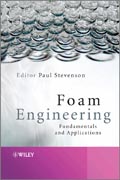
Containing contributions from leading academic and industrial researchers, this book provides a much needed update of foam science research. The first section of the book presents an accessible summary of the theory and fundamentals of foams. This includes chapters on morphology, drainage, Ostwald ripening, coalescence, rheology, and pneumatic foams. The second section demonstrates how this theory is used in a wide range of industrial applications, including foam fractionation, froth flotation and foam mitigation. It includes chapters onsuprafroths, flotation of oil sands, foams in enhancing petroleum recovery, Gas-liquid Mass Transfer in foam, foams in glass manufacturing, fire-fighting foam technology and consumer product foams. Key features: Foam fractionation isan exciting and emerging technology, starting to gain significant attention Discusses a vital topic for many industries, especially mineral processing, petroleum engineering, bioengineering, consumer products and food sector Links foam science theory to industrial applications, making it accessible to an engineering science audience Summarizes the latest developments in this rapidly progressing area of research Contains contributions from leading international researchers from academia and industry INDICE: About the Editor xv Contributors xvii Preface xix 1 Introduction 1Paul Stevenson 1.1 GasLiquid Foam in Products and Processes 1 1.2 Content of This Volume 2 1.3 A Personal View of Collaboration in Foam Research 3 Part I Fundamentals 5 2 Foam Morphology 7 D. Weaire, S.T. Tobin, A.J. Meagher and S. Hutzler 2.1 Introduction 7 2.2 Basic Rules of Foam Morphology 7 2.2.1 Foams, Wet and Dry 7 2.2.2 The Dry Limit 9 2.2.3 The Wet Limit 11 2.2.4 Between the TwoLimits 11 2.3 Two-dimensional Foams 11 2.3.1 The Dry Limit in 2D 11 2.3.2 TheWet Limit in 2D 12 2.3.3 Between the Two Limits in 2D 12 2.4 Ordered Foams 152.4.1 Two Dimensions 15 2.4.1.1 The 2D Honeycomb Structure 15 2.4.1.2 2D Dry Cluster 15 2.4.1.3 2D Confinement 15 2.4.2 Three Dimensions 16 2.4.2.1 3D Dry Foam 16 2.4.2.2 3D Wet Foam 17 2.4.2.3 Ordered Columnar Foams 18 2.5 Disordered Foams 19 2.6 Statistics of 3D Foams 20 2.7 Structures in Transition: Instabilities and Topological Changes 21 2.8 Other Types of Foams 22 2.8.1 Emulsions 22 2.8.2 Biological Cells 22 2.8.3 Solid Foams 23 2.9 Conclusions 24 3 Foam Drainage 27 Stephan A. Koehler 3.1 Introduction 27 3.2 Geometric Considerations 29 3.3 A Drained Foam 33 3.4 The Continuity Equation 35 3.5 Interstitial Flow 36 3.6 Forced Drainage 38 3.7 Rigid Interfaces and Neglecting Nodes: The Original Foam Drainage Equation 41 3.8 Mobile Interfaces and Neglecting Nodes 43 3.9 Neglecting Channels: The Node-dominated Model 46 3.10 The Network Model: Combining Nodes and Channels 48 3.11 The CarmanKozeny Approach 50 3.12 Interpreting Forced Drainage Experiments: A Detailed Look 51 3.13 Unresolved Issues 53 3.14 A Brief History of Foam Drainage 54 4 Foam Ripening 59 Olivier Pitois 4.1 Introduction 59 4.2 The Very Wet Limit 59 4.3 The Very Dry Limit 61 4.3.1 Inter-bubble Gas Diffusion through Thin Films 61 4.3.2 von Neumann Ripening for 2DFoams 62 4.3.3 3D Coarsening 64 4.4 Wet foams 65 4.5 Controlling the Coarsening Rate 69 4.5.1 Gas Solubility 69 4.5.2 Resistance to Gas Permeation 70 4.5.3Shell Mechanical Strength 70 4.5.4 Bulk Modulus 71 5 Coalescence in Foams 75 Annie Colin 5.1 Introduction 75 5.2 Stability of Isolated Thin Films 76 5.2.1 Experimental Studies Dealing with Isolated Thin Liquid Films 76 5.2.2 Theoretical Description of the Rupture of an Isolated Thin Liquid Film 77 5.3 Structure and Dynamics of Foam Rupture 78 5.4 What Are the Key Parameters in the Coalescence Process? 81 5.5 How Do We Explain the Existence of a Critical Liquid Fraction? 86 5.6 Conclusion 89 6 Foam Rheology 91 Nikolai D. Denkov, Slavka S. Tcholakova, Reinhard Höhler and Sylvie Cohen-Addad 6.1 Introduction 91 6.2 MainExperimental and Theoretical Approaches 93 6.3 Foam Visco-elasticity 95 6.3.1Linear Elasticity 95 6.3.1.1 Monodisperse Dry Foam 95 6.3.1.2 Effects of Bubble Polydispersity and Liquid Content 96 6.3.2 Non-linear Elasticity 98 6.3.3 Linear Relaxations 99 6.3.3.1 Slow Relaxation 99 6.3.3.2 Fast Relaxation 101 6.3.4 Shear Modulus of Particle-laden Foams 102
- ISBN: 978-0-470-66080-5
- Editorial: John Wiley & Sons
- Encuadernacion: Cartoné
- Páginas: 544
- Fecha Publicación: 06/01/2012
- Nº Volúmenes: 1
- Idioma: Inglés
